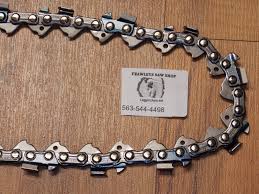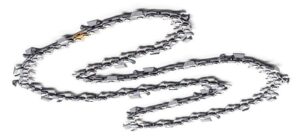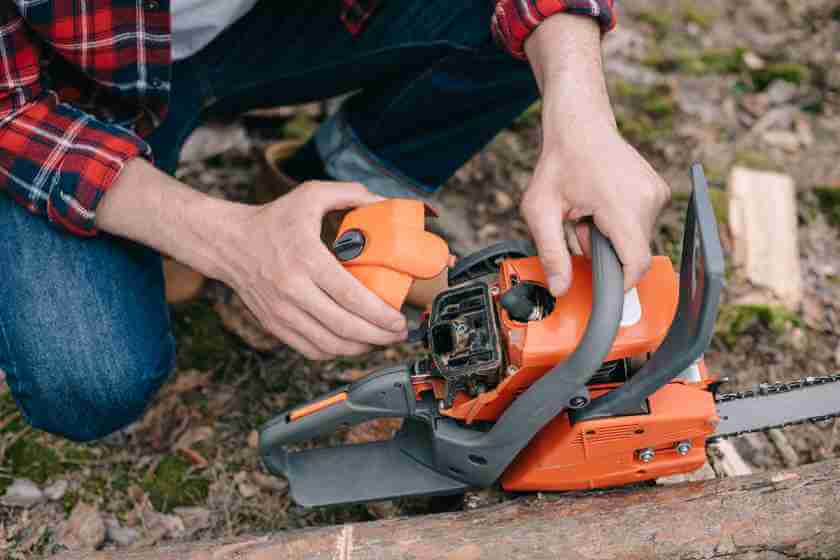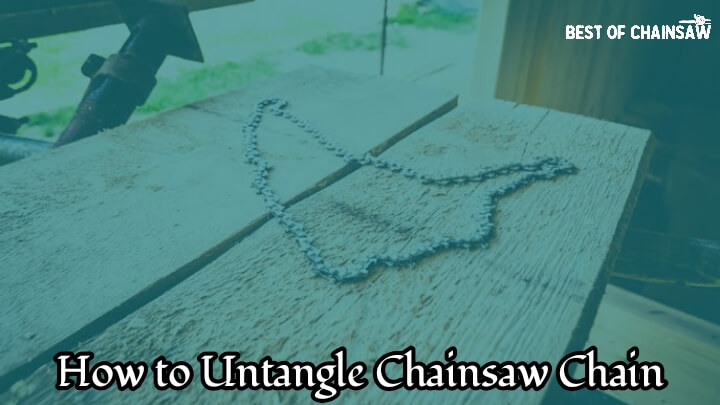In the event of a chainsaw’s chain getting tangled on a tree branch or some other object, you need to know how to get everything back in order. What you don’t want to do is pull hard on the saw while it’s still running, as this could lead to serious injury.
An important part of the cutting is making sure that your chainsaw’s chain doesn’t end up getting stuck on anything.
In fact, if you’ve been using one for long enough you probably already know that there are some tips and tricks—most notably turning the unit off before starting to cut—that will help prevent such issues from happening in the first place.
However, what happens when something goes wrong and your cutting path is blocked by an object like a tree branch? It’s quite easy to fix such problems and, best of all, you can do it without turning off your chainsaw; we’ll provide instructions below on how to untangle chainsaw chains.
Note: some chainsaw saws work with an inertia chain brake. This is a device that will stop the saw if it is moving too quickly or for any other reason becomes unsafe.
If your chainsaw has one of these, then you need to turn the unit off before attempting to untangle the chain. Always remember to unplug your machine after use so that no one gets hurt while it’s still plugged in.
Table of Contents
Tool(s) needed: Round-link

8mm wrench, flathead screwdriver Square-link: wire cutters/side cutter or angle grinder/metal file
If the problem happens to be a bent bar, begin by removing it from the guide and placing it in a vice with one side hanging free so it doesn’t bend as you work on it.
If there’s any corrosion or dirt that prevents the removal of the bar, use a wire brush and pliers to remove as much as possible before filing down the rest. Once this is done, you can begin realigning your saw using an 8mm wrench and a metal file or flathead screwdriver.
For round-link chains
Place the tip of the screwdriver between two links and tap around until they move. Try to alternate which link you move so it doesn’t continue to twist out of alignment.
For square link chains: cut one side of each loop with wire cutters then pull them apart with pliers. Continue doing this until all four loops are detached from each other.
Once you have the loops out of alignment, use an 8mm wrench to turn the bar until both sides are touching. Be sure not to overtighten or else you risk damaging the screw.
There should be about 1/8″ between each side of the bar and saw chain. To check if it’s tight enough, try spinning one of the chains. If they spin freely without any tension on them, readjust your bar accordingly then tighten again with an 8mm wrench.
For square-link chains
Using wire cutters or a metal file, shorten each individual link by cutting off one side at a time. Once all four are short enough that they can’t touch, give each loop another once-over with pliers to make sure none of them are catching on to each other.
Once everything is tightly in place and there is no longer any tension between the links, reattach your bar and give it a spin (making sure it doesn’t hit anything) for about 10 seconds.
When you take the bar off to inspect it, check both sides of each link as well as the center. If they’re even slightly touching, tighten your chain another 1/8″. Repeat this step as many times as necessary until all of your loops move freely without ever touching again.
Remove the bar
Put on your safety equipment — gloves, eye protection, and earplugs — before starting this process. Attempting to take off the bar while the saw is still running is dangerous because you could be hit by the chain if it malfunctions. There are two possible ways to remove the bar:

Locate where chainsaw joints join together then screw or twist them apart
Be sure that the saw’s power is turned off and there aren’t any witnesses nearby before attempting this step, as it requires users to handle their power tools without extra protection besides gloves.
The first method involves opening the blade guard and locating the screws on either side of the chain which attaches it to the bar.
Loosen them with a screwdriver — turning counterclockwise — until they’re both loose enough for you to slide out one end of the chain from the other using pliers.
The other method requires you to locate the saw’s joint and use a wrench or adjustable pliers to twist it open, separating the chain and freeing your stuck piece of metal.
Clear out any dirt and grime from inside the joint

Use a screwdriver to remove any screws which still fasten the two ends together. Then, take your time removing any stubborn pieces of metal using an adjustable wrench or pair of pliers if necessary.
Don’t rush; otherwise, you risk damaging your tools or injuring yourself in the process.
Once all of the foreign objects are removed from within the joint, continue unscrewing until both sides separate completely so that you may remove your stuck piece of metal.
Locate a hammer and a chisel, then use them to break apart the joint
This is the last resort for those who cannot find a way to separate two pieces of metal using any other tools. The process requires you to place one end against the saw’s surface so that if you strike it with your hammer it will hit the opposite side as well as force its way between both sides of the joint until they part ways completely.
It is important to not strike directly on top of your piece of metal, or else there could be significant damage done to it which makes it unable to function properly in future chainsaw chains.
When striking the metal, try doing it at slight angles in different spots to help it break apart more smoothly.
While you were removing your piece of metal, the chain should have fallen off around it, exposing a space between two pieces of metal on either side. However, this isn’t always the case; if there is still another piece of metal between yours and the rest of the cutters, you’ll need to remove that one first before attempting to get it back together again.
A better way to untangle a chain is using the “bump fire” technique, which involves bumping the base of the chainsaw downwards with your knee, while at the same time twisting it around in a circular motion with your hands.
Be sure to follow instructions closely because if you don’t you could end up injuring yourself even more.
If neither one of these techniques work for you then maybe giving our customer service number a call might be the best option for resolving this issue quickly and painlessly.
However, when calling us please have your model and serial numbers ready as well as an approximate date of purchase.
Just in case you’re not sure about when your chainsaw was bought, do an Internet search using the model number and serial numbers to identify a rough date of purchase.
Things to keep in mind when working with a chainsaw
Keep your chains oiled at all times, after every use before storing them again. This will prevent rusting, pitting, freezing etcetera. Do not leave them outside for extended periods of time unless necessary because rainwater over time can degrade their links severely if left out in the open.
Never let children play with chains. Their small hands and fingers are too weak to be able to handle a chain with enough force.
Always wear gloves while working. It is highly recommended that you use leather gloves while operating chainsaws, just in case it kicks back unexpectedly. However, if your job does not require this then I recommend that you always wear them even when not working just to keep yourself alive.
Never, ever use a chainsaw on anything other than wood. Cement blocks, metal bars, or concrete walls can severely damage the blade resulting in loss of control of the machine and human injury.
NEVER EVER use a bar larger than what your saw was designed for – it will make your saw difficult to handle and can cause it to “kickback” in a similar fashion to when a horse kicks you.
Always keep in mind that chainsaws are extremely dangerous and can hurt you if used incorrectly. If you follow these precautions, your work will be safe and efficient.
Final Verdict
The process on how to untangle chainsaw chain will depend on where your last stuck piece lies within the chainsaw chain: if it’s closer to where you began cutting than it is to the teeth — called “depth gauges” — then you must grab it with your wrench and unscrew the joint where it lies.
If it’s closer to the teeth than your starting point, you must instead grab it with pliers and turn yourself counterclockwise until all of the pieces separate again.
You may like our comparisons on ego cs1800 vs cs1804 and Stihl ms170 vs Husqvarna 120.

